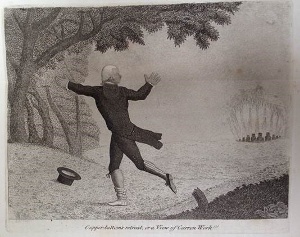This is a past event
"John Kay, Print Culture and the Philosophy of Laughter"
Wendy McGlashan (History of Art, Aberdeen)
This paper focuses on an etching by John Kay entitled Copper bottom’s retreat, or a View or Carron Work!!! (1797): a satirical portrait of William Forbes of Callendar, published during the period of social unrest provoked by the passing of the Scottish Militia Act in July 1797. In Falkirk, opposition to enforced military service combined with existing resentments of the improving landowner to culminate in a particularly embarrassing event in the life of William Forbes. As Deputy Lieutenant for Falkirk, it was Forbes’s duty to procure a ‘Militia List’ of local men eligible for compulsory service. Intense resistance ensued and one night a large band of men surrounded Callendar House. Forbes fled for the woods and looking back to see the flickering glow from Carron Works he mistakenly imagined that the mob had set fire to his home: an event promptly satirised by Kay. 
In Reflections Upon Laughter (1750) Francis Hutcheson presents Laughter as a remedy for discontent, arguing that ‘ludicrous images’ have a propensity to dissipate ‘fretfulness, anxiety, or sorrow and reduce the mind to an easy happy state.’ Hutcheson commends the use of ‘burlesque allusion’ and praises the seventeenth-century examples of Hudibras and Don Quixote, while Allan Ramsay in his Essay on Ridicule (1753) praises the graphic works of William Hogarth for inciting moral virtue in a universally accessible language. In this paper, Copper bottom’s retreat is examined within this philosophical context and it is demonstrated that Kay employed his on-going study of European Old Master and contemporary British prints to create a complex, multi-layered satire, designed to communicate with different levels of society. Forbes’s 1798 commissioning of a full-length portrait by Sir Henry Raeburn is reconsidered and reframed as an attempt to reassert his dignity and authority through high-art: something that did not go exactly to plan.
Wendy is a second-year PhD student at the University of Aberdeen and the recipient of a PhD Scholarship from the Carnegie Trust for the Universities of Scotland. The provisional title of her thesis is Enlightenment Society Observed: The Edinburgh Portraits of John Kay 1784-1822. It is a close analysis of the work of an as yet little-studied Scottish artist and examines the assertion that the work of Kay is ‘solely of antiquarian value’, reconsidering his significance to the broader histories of both Scottish and British art and culture.
With a background in textile design and surface decoration at Gray’s School of Art, and after working as a textile designer, she transferred her design skills to a career in gardening, working firstly for the National Trust for Scotland, and later for the Beechgrove Garden, where she was appointed Head Gardener in 2010. Injury brought her gardening career to an abrupt end and in 2012 she commenced her studies at the University of Aberdeen.

